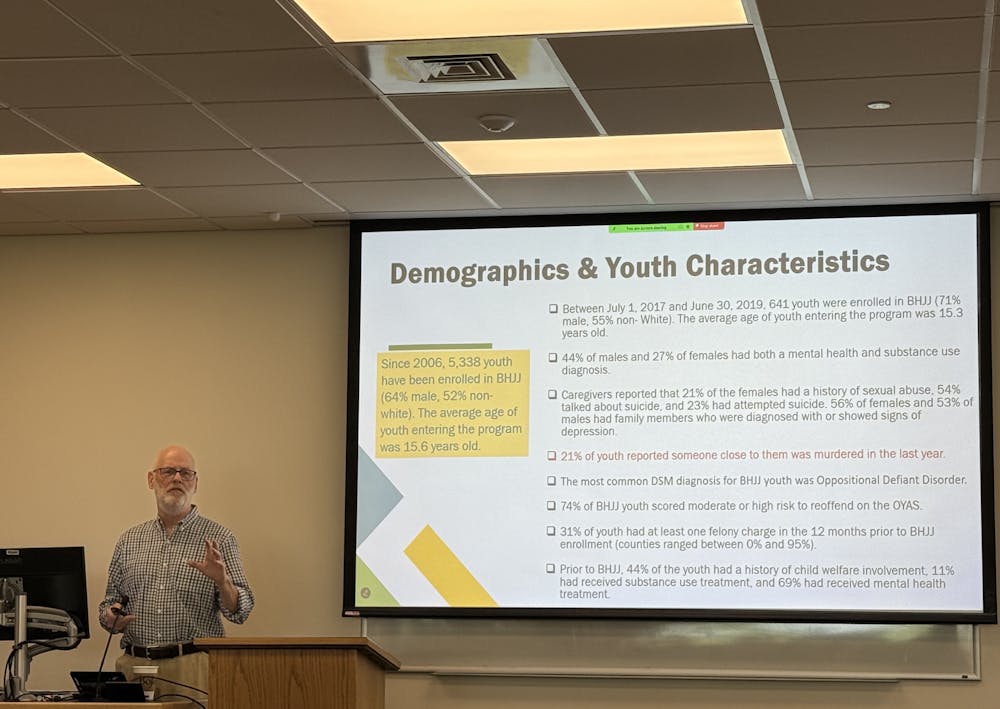Dr. Daniel Flannery, Case Western Reserve University professor and director of the Begun Center for Violence Prevention Research and Education — a non profit research center dedicated to social justice and violence prevention — presented his research and perspective on the impact on mental health and violence to University students Friday in Ridley Hall. Flannery discussed the cycle of violence from adolescence to adulthood, and the correlation between unrestricted gun access and mass violence.
This event, titled “Challenges to Positive Youth Development: Violence and Mental Health in Everyday Life”, was co-sponsored by the Youth-Nex Center — which aims to prevent developmental risk such as violence, physical and mental health issues through scholarship — and Gun Violence Solutions Project, a University-wide effort to develop and implement actionable solutions to mitigate gun violence.
After introducing his work with the Begun Center, Flannery presented a model he created detailing the developmental sequence of violent behavior from preschool to adolescence. Flannery noted that there are many factors which contribute to violent behaviors in youth including perinatal risks such as low birth weight, neurological deficits, victimization, peer rejection and home environment, as well as many forms of intervention to preemptively prevent violent behaviors.
“If we don't start early and identify these factors and do something about it, that window of opportunity to affect change gets smaller and smaller and smaller as our youth get older and older,” Flannery said. “The effort it takes to affect that change because of all of these intersectional factors becomes much more difficult, and much more expensive [to treat] with time.”
Kyla Rayner, audience member and graduate College student, said that she attended this event to learn more about violence prevention as a PhD candidate in the Clinical and School Psychology program. Rayner said that she appreciated Flannery’s interdisciplinary approach to research and his promotion of open conversations about the difficult topics of mental health issues and youth violence.
“It's important to have different voices and an interdisciplinary approach to resolving complex issues that really affect everyone, especially when we think about school shootings, how to prevent school shootings and how to prevent these issues from arising using a variety of perspectives and approaches,” Rayner said.
According to Flannery, a major catalyst for what he deems the “cycle of violence” is exposure to violence at a young age. With the Begun Center, Flannery conducted a study of 6,000 children aged six and below using reports from caregivers and found that approximately one out of five children have been exposed to violence either as a victim or a witness.
Flannery then repeated this study using self-report surveys on 10,000 children and adolescents aged 8 and above, concluding that three out of four of survey respondents were exposed to at least one form of violence throughout their lifetime. Nearly 70 percent of these children also reported at least one trauma symptom as a result of witnessing violence.
During this presentation, Flannery also discussed the correlation between gun access and violent behaviors in youth, particularly school shootings. He said that although it is the individual who chooses to take lives in school shootings, not the gun, research has repeatedly shown that when young people are restricted from gun access, gun violence is less likely to occur.
Flannery offered methods of decreasing gun access to America’s youth through “common sense” gun laws which include implementing universal background checks, permitting information sharing across school threat assessment teams and voting for state and federal legislators who endorse gun control. According to Flannery, there are many ways to address high rates of gun violence in the United States, and the government’s unwillingness to enforce preventative policies needs to be questioned.
“We as a society have made the decision that an individual's right to purchase and have as many lethal weapons as they want supersedes anybody else's right to safety and security,” Flannery said. “The number of guns out there matters, the easy accessibility of those weapons matter.”
In the question and answer portion of this event, an audience member asked Flannery what the lingering effects of a school shooting are on the culture of a university, such as the University community after the Nov. 13, 2022 on-grounds shooting which killed three students. Flannery responded by stating the trauma responses of each individual are different, and an individual does not need to directly witness a tragic event to be psychologically, socially and emotionally impacted for many years.
“Just because you weren't there on the bus or on the sidewalk doesn't mean you weren't significantly impacted and aren't impacted the next time something occurs, that brings you back to [that moment],” Flannery said.







